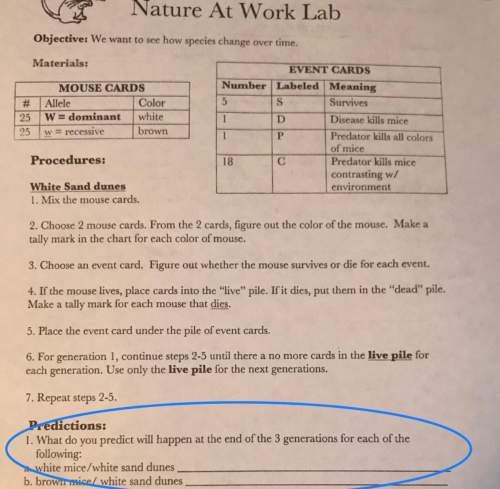
Biology, 21.02.2020 02:42 keigleyhannah30
Consider the events that describe the progress of a protein that will be secreted from the cell. 1. SRP binds to the growing polypeptide chain and to the ribosome. 2. Translation resumes. 3. SRP binds to its receptor. 4. The signal sequence is cleaved. 5. Protein synthesis begins in the cytosol. 6. Translation pauses. A. 5 → 1 → 6 → 3 → 2 → 4 B. 5 → 6 → 1 → 3 → 2 → 4 C. 3 → 6 → 1 → 2 → 4 → 5

Answers: 1


Other questions on the subject: Biology


Biology, 22.06.2019 02:30, ineedhelp2285
Part e - sequence of metabolic processes each of the different cellular metabolic pathways occurs in a specific order. consider aerobic cellular metabolism from the beginning to end. what is the sequential order of the metabolic processes that starts with glucose and results in the production of carbon dioxide, water, and atp? put the following in the correct sequential order. rank from earliest to latest. to rank items as equivalent, overlap them. view available hint(s) acetyl coaglycolysiscitric acid cycle pyruvate finishstartstart background image electron transport chain background image finish background image submit cellular metabolism is often expressed as an equation. this equation puts into perspective, on a general scale, the substances needed to start cellular metabolism and the products that come out of it. the equation represents the overall product yield after every step of cellular metabolism is complete (i. e., glycolysis through the electron transport system). in this part of the tutorial you task will be to put together the equation that represents cellular metabolism. you will also learn the products that result from each metabolic pathway and the role that some these products play in the production of atp.
Answers: 2

Biology, 22.06.2019 06:50, Shaylaharrison15
The kidney filters potentially toxic substances in the blood, and thus “clears” the blood of those substances. this clearance function is dependent upon and proportional to the diffusion gradient of the substance across filtering capillaries, i. e. if the concentration of the substance is doubled, twice as much will be cleared from each ml of blood that is filtered. suppose that the body produces a constant amount of a substance x per unit of time. the kidneys eliminate substance x at a rate directly proportional to the concentration of the substance and the volume of blood cleared each minute (c): elimination = c × [x], where [x] is the steady-state concentration of substance x. imagine an individual with an initial concentration of x equal to [x]0 who develops kidney disease. her baseline clearance c0 drops to one half of the original (½c0). what is the new steady state concentration of x? (for simplicity, assume that substance x is 100% filtered by the kidney).
Answers: 1

Biology, 22.06.2019 12:40, martinbricein10
Select the correct answer from each drop-down menu. the lac operon in e. coli regulates genes that code for enzymes required for breakdown of lactose. the lac operon is operon that is activated in the presence of .
Answers: 1
You know the right answer?
Consider the events that describe the progress of a protein that will be secreted from the cell. 1....
Questions in other subjects:



Mathematics, 16.10.2019 11:50


History, 16.10.2019 11:50

Geography, 16.10.2019 11:50


Social Studies, 16.10.2019 11:50





